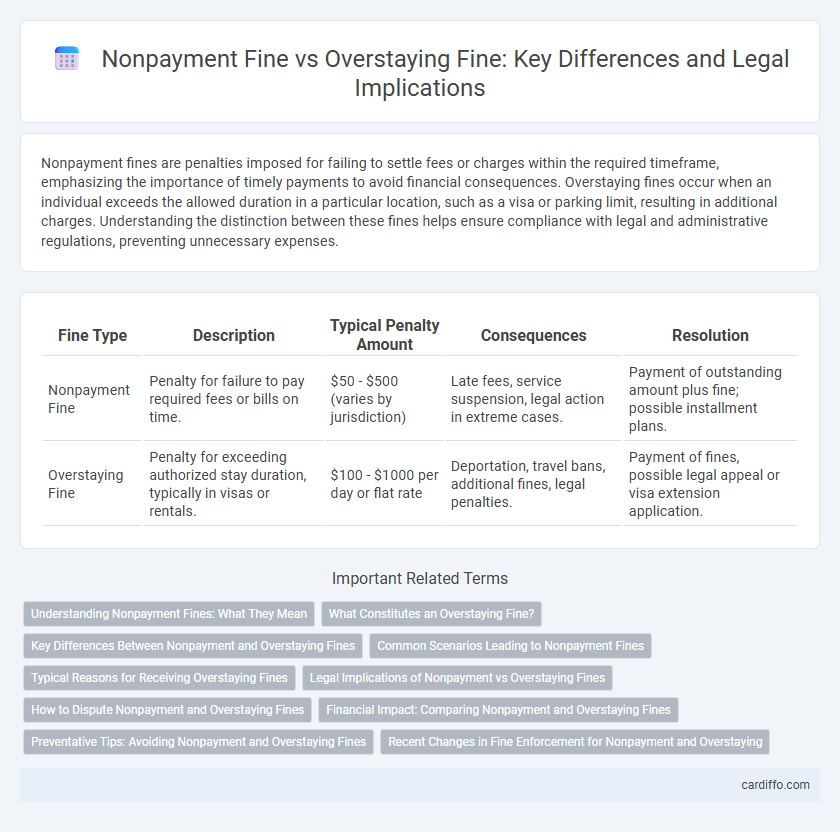Nonpayment fines are penalties imposed for failing to settle fees or charges within the required timeframe, emphasizing the importance of timely payments to avoid financial consequences. Overstaying fines occur when an individual exceeds the allowed duration in a particular location, such as a visa or parking limit, resulting in additional charges. Understanding the distinction between these fines helps ensure compliance with legal and administrative regulations, preventing unnecessary expenses.
Table of Comparison
| Fine Type | Description | Typical Penalty Amount | Consequences | Resolution |
|---|---|---|---|---|
| Nonpayment Fine | Penalty for failure to pay required fees or bills on time. | $50 - $500 (varies by jurisdiction) | Late fees, service suspension, legal action in extreme cases. | Payment of outstanding amount plus fine; possible installment plans. |
| Overstaying Fine | Penalty for exceeding authorized stay duration, typically in visas or rentals. | $100 - $1000 per day or flat rate | Deportation, travel bans, additional fines, legal penalties. | Payment of fines, possible legal appeal or visa extension application. |
Understanding Nonpayment Fines: What They Mean
Nonpayment fines are charges imposed when a required payment, such as a toll or utility bill, is not settled by the deadline, leading to legal or administrative penalties. These fines are distinct from overstaying fines, which specifically target unauthorized extensions of time in areas like parking or visa durations. Understanding nonpayment fines involves recognizing their role in enforcing timely payments and preventing financial losses for service providers or authorities.
What Constitutes an Overstaying Fine?
An overstaying fine is imposed when an individual remains in a country beyond the authorized period granted by their visa or entry permit. This fine typically accrues per day of unauthorized stay and can significantly increase depending on local immigration laws. Overstaying fines differ from nonpayment fines, which relate to failure in fulfilling financial obligations rather than unauthorized residence duration.
Key Differences Between Nonpayment and Overstaying Fines
Nonpayment fines are imposed when a required payment, such as a toll or fee, is not submitted within the designated timeframe, directly impacting financial compliance. Overstaying fines occur when an individual exceeds the authorized duration of stay, often in hotels, parking areas, or visa terms, emphasizing time violations. The key differences lie in the nature of the offense: nonpayment fines relate to missing monetary obligations, while overstaying fines concern breaches in time limits and authorization periods.
Common Scenarios Leading to Nonpayment Fines
Common scenarios leading to nonpayment fines include failure to pay utility bills, traffic tickets, or rent on time, resulting in accumulating penalties and interest. Overstaying fines typically arise when individuals remain beyond the permitted time in rental properties, hotels, or visa durations, triggering additional fees or legal actions. Understanding these distinct causes helps in managing and preventing financial liabilities related to nonpayment and overstaying penalties.
Typical Reasons for Receiving Overstaying Fines
Typical reasons for receiving overstaying fines include exceeding the authorized visa duration, failure to renew or extend the visa on time, and neglecting to report changes in travel plans to immigration authorities. Overstaying fines often outweigh nonpayment fines, reflecting stricter enforcement to deter unauthorized residence beyond the permitted period. Immigration agencies use electronic monitoring and exit records to detect and impose penalties for overstaying violations.
Legal Implications of Nonpayment vs Overstaying Fines
Nonpayment fines carry legal consequences such as increased penalties, potential court actions, and damage to credit scores, emphasizing the importance of timely payment. Overstaying fines often result in more severe immigration consequences, including deportation, visa cancellations, and future entry bans, highlighting the critical impact on legal residency status. Both fines underscore distinct legal risks but overstaying fines typically carry harsher penalties affecting an individual's legal ability to remain or return to a country.
How to Dispute Nonpayment and Overstaying Fines
Disputing nonpayment and overstaying fines requires gathering evidence such as receipts, travel documents, or timestamps that prove payment or compliance with the time limits. Filing a formal appeal with the relevant authority, often through an online portal or in-person office, includes submitting supporting documentation and a written statement explaining the dispute. Understanding the specific regulations and deadlines for appeals in each jurisdiction enhances the chances of successfully contesting fines related to nonpayment or overstaying.
Financial Impact: Comparing Nonpayment and Overstaying Fines
Nonpayment fines typically incur a fixed penalty amount, often ranging from $50 to $200, depending on the jurisdiction, leading to immediate financial strain. Overstaying fines tend to escalate based on the duration of the overstay, with daily surcharges accumulating beyond the initial penalty, significantly increasing the total cost. Both fines can adversely affect credit scores and may result in additional legal fees or penalties if left unpaid, amplifying the overall financial impact.
Preventative Tips: Avoiding Nonpayment and Overstaying Fines
To avoid nonpayment fines, always confirm payment deadlines and maintain clear records of all transactions and receipts. When it comes to overstaying fines, monitor your permit or reservation expiry times closely and set reminders ahead of due dates to ensure timely departure. Utilizing digital tools or apps for tracking payments and stay durations can significantly reduce the risk of accumulating fines related to nonpayment or overstaying.
Recent Changes in Fine Enforcement for Nonpayment and Overstaying
Recent changes in fine enforcement for nonpayment and overstaying highlight stricter penalties and increased monitoring by authorities. Nonpayment fines now incur higher daily rates and faster escalation, while overstaying fines include enhanced tracking through biometric systems to prevent evasion. These measures aim to ensure timely compliance and reduce violations across urban areas.
Nonpayment fine vs Overstaying fine Infographic

 cardiffo.com
cardiffo.com